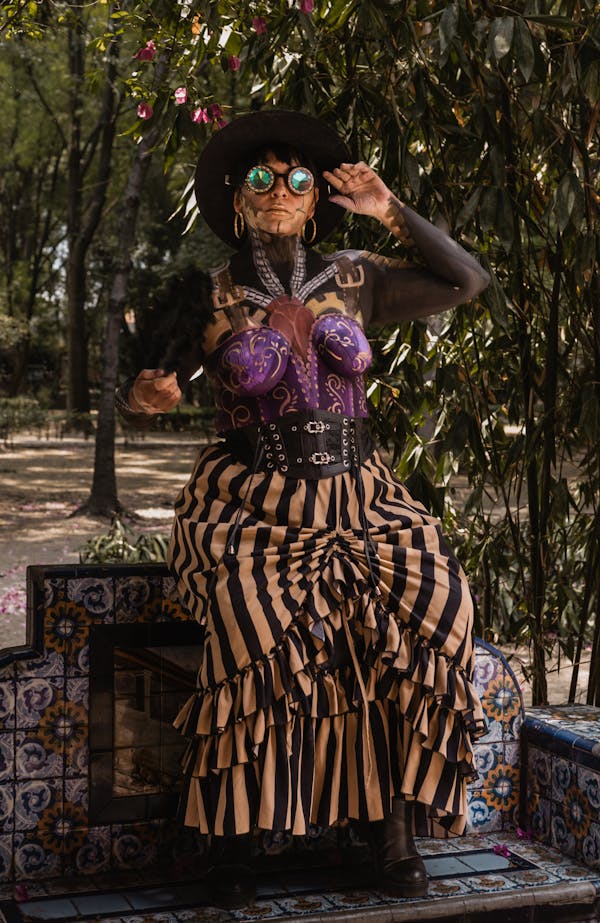Steampunk style fuses Victorian elegance with imaginative, retro-futuristic technology, creating a unique fashion statement. Rooted in 19th-century industrial aesthetics and inspired by literary classics, this genre invites you to wear history reimagined. Exploring intricate gears, corsets, and leather, steampunk fashion offers bold creativity grounded in storytelling and art, appealing to those who seek both nostalgia and innovation in their wardrobe.
Defining Steampunk: Origins, Themes, and Core Aesthetics
You’ll discover, on this page: https://steampunkfashion.co.uk/, an exemplary showcase of steampunk’s core appeal, where Victorian-inspired aesthetics meet retro-futuristic creativity. Steampunk is a genre and design philosophy that reimagines the 19th century’s Industrial Revolution, blending ornate fashion, alternative history genre narratives, and the spectacle of steam-powered machinery concepts. The term “steampunk” was introduced by author K. W. Jeter in 1987, yet its foundations were laid in the imaginative worlds of Jules Verne and H. G. Wells. These pioneers imagined fantastical contraptions—airships, advanced submarines, clockwork automatons—well before the modern movement took shape.
Also to read : Elevate Your Evening Attire: Discover the Art of Silk Accessories in Manchester
The visual identity of steampunk is unmistakable and rich with vintage industrial fashion innovations: picture brass gears, exposed cogs, polished copper pipes, and heavily riveted mechanisms woven seamlessly into outfits and environments. Attire often channels the Victorian era influences—long coats, corsets, intricate waistcoats, and sturdy boots—complemented by iconic accessories such as goggles, pocket watches, and mechanical gadgetry. Each detail underscores an admiration for craftsmanship and creativity.
In storytelling and art, steampunk’s core themes revolve around the speculative: what if scientific dreams of the past had come true? Worlds powered by imaginative steam technology are filled with dirigibles, elegant clockwork contrivances, and bold adventure. Whether through fantasy and sci-fi fusion or in actual maker communities, steampunk encourages exploring the balance between history and possibility.
Have you seen this : Essential Timeless Jewelry Must-Haves for Every Woman in the UK
Steampunk in Literature, Media, and Subculture
Literary Foundations and Iconic Works
Steampunk literature and authors have established a distinctive branch of alternative history genre, where intricate mechanical gadgetry meets Victorian-inspired aesthetics. Early precursors by Jules Verne and H.G. Wells shaped the fantasy and sci-fi fusion central to the movement. More recent writers, such as K.W. Jeter, expanded these ideas, fueling creative explorations in industrial revolution aesthetics and imaginative retro-futuristic design. Many tales unfold in fictional steampunk cities or alternate timeline cultural artifacts, inviting readers into elaborate universes driven by steam-powered machinery concepts.
Steampunk on Screen: Film, Anime, Television
Notable film and television steampunk settings—from Miyazaki’s ornate airships to the analog wonders of Wild Wild West—demonstrate the genre’s adaptability. Visual features like brass gear artwork, mechanical animal designs, and gothic architectural motifs evoke both vintage industrial fashion and technological anachronisms in design. The cyberpunk crossover elements in series such as The League of Extraordinary Gentlemen highlight the evolving dialogue between steampunk and sister subgenres like dieselpunk and clockpunk.
Beyond Fiction: Subculture, Games, and Cosplay
Steampunk-inspired video games like Dishonored and BioShock Infinite use clockwork accessories and steam-powered vehicles to deepen immersion. Themed conventions foster cosplay and roleplaying outfits, celebrating creative DIY costume creation tips and the artistry of leather and brass materials. Within these spaces, mechanical wings and props, plume and feather adornments, and elaborate cosplay and roleplaying outfits showcase the subculture’s enduring energy and innovation.
Victorian-Inspired Steampunk Fashion: Elements, Style Guides, and Practical Tips
Corsetry and waistcoats are central to Victorian-inspired aesthetics and define much of steampunk’s retro-futuristic design. These garments reference Victorian era influences by combining structured shapes with unique leather and brass materials. Adding goggles and eyewear styles over a top hat or integrating mechanical gadgetry like clockwork accessories supports that fusion of vintage industrial fashion and modern fantasy.
Steampunk ventures beyond a single look, offering substyles such as Steampunk Gothic—marked by dramatic color palettes for vintage looks and intricate jewelry featuring gears and clock parts. Western Steampunk incorporates leather and brass materials, boots, and wide-brimmed hats, while Lolita Steampunk features detailed lace and petite corsetry. Inspirations are rooted in British craftsmanship and historical techniques, but each substyle introduces creative alternatives and themed party ideas for enthusiasts.
Building a steampunk wardrobe benefits from DIY costume creation tips: upcycling and repurposing materials not only keeps projects affordable, but also invites personal touches—think bespoke goggles and inventive jewelry featuring gears and clock parts. For themed home interior design, combining brass gear artwork and whimsical upcycled decor will amplify the industrial revolution aesthetics.











